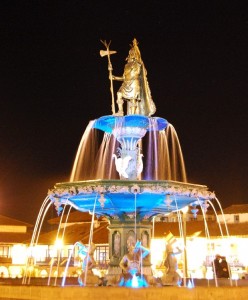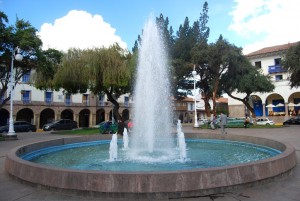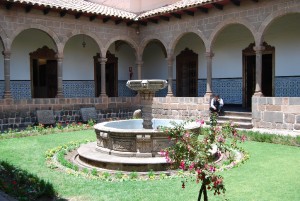Fountains, Patios, and Plazas are Cuzco’s Life

To walk around Cuzco is to move from spaces lined by white walls and blue window frames to openings where more light enters, flowers bloom, and often water flows. Cuzco’s plazas are its grace. People sit there, talk, walk and play. A similar arrangement organizes its old, Spanish and Moorish style homes behind those white walls. They too have closed spaces that open onto an open area of light, bloom, and often water, the patio.
From above, when you look out on old Cuzco, you see the undulating orange tile, but also the breaks both within buildings and between them where greenery often shows. Cuzco is a city of tiled buildings and gaps.
These patios were meant to be the life of the home, just as the plazas are the public life of the city. They bring together values of privacy, but also openness to the sky and its light and to the fresh air and breezes that come over the tiled roofs.

Although windows may break the walls’ mass, on the second floors, at ground level only doors mark changes in the overwhelming white. Of course the exception to this is where businesses have broken into the walls and require windows to show their wares. Otherwise it is as if the houses turned their back on the street and opened instead on that grand internal courtyard, the patio.
But one can turn that image such that one can see the city beginning in each of the patios. Pérez Ordoñez captures this when he writes.

The generating element of [the] urbanism of the Islamic cities [of Spain, from which American cities like Cuzco descend,] is the home from the inside out. The urban genesis begins in the wast-al-dar(patio), around which the domestic rooms are arranged. Other houses, one after another, grow next to each other making for large blocks of buildings which are deeply penetrated by narrow streets permitting access to each. Each of these blocks and neighborhoods, formed by the collateral sharing of groups of houses, are a veritable settlement of extended families.

If, as Pérez argues, the patio generates the city, the city has its own system of patios around which each neighborhood and finally the whole city is organized. It is a hierarchy of openings, from little ones at the center of neighborhood life, especially its festive but also its day to day life, to the large grand plaza, the Plaza de Armas, that is the center of the city.
In this, Cuzco, like many of the highland cities, is different in that it has two plazas at its heart, the Plaza de Armas and the Plaza de Regocijo. Both where formed when the Spanish pushed houses across a part of the great Inca plaza at the center of Imperial Cuzco and covered up the stream that crossed it.

The focus on water, unlike in Inca times, shifted to the controlled flow through fountains. In Islamic Spain flowing water appearing in the courtyard of the city’s Mosques suggested purity. They, along with the gardens around them, reminded people of paradise, the reward of the good.
Plazas have gardens and often fountains of running water, such as the fountain of the Plaza de Armas, or the shooting one of the Plaza of Regocijo. Fountains were also found in the patios to make the complete image of paradise which was to be connected with the patriarchal family that occupied it and whose life opened on it.
Unfortunately many of Cuzco’s colonial mansions are either in a state of disrepair or have been broken down for modern uses to where almost all that is left is the walls and tiled roofs. The Comercio, the most important daily of Peru, reports that the INC (the National Institute of Culture) reports that 349 of the homes are in serious condition and 153 in emergency status, out of the 2800 buildings that form the city’s colonial core.

As the Comercio notes part of the problem is that the people who inhabit the buildings are often poor and do not have resources to keep the buildings well maintained. In some cases this is because, as in other parts of the world, the old families who have inherited the buildings no longer have the means to keep them up, and in other cases it is because the old families have long since moved to the suburbs. Their old homes have been divided and subdivided to form hovels for the poor.
The casonas, the Spanish Moorish style buildings of colonial Cuzco have been broken up, either for modern businesses or for low-income housing.
Nevertheless, while walking the streets one can occasionally see the old patios through open doors. In them sometimes remain the old, utopian fountains. Many are dry. But sometimes one comes across a patio in good repair with its fountain still flowing in memory and hopes of paradise, just as the fountains of the city’s plazas still flow to remind one of the core values of city life, urbanism and its authorities provide the flow of life and salvation.





